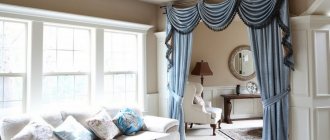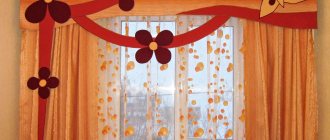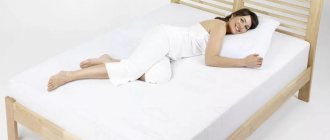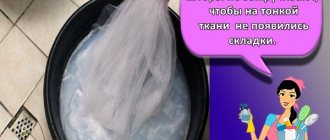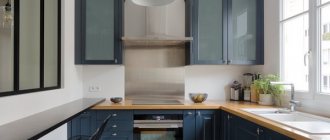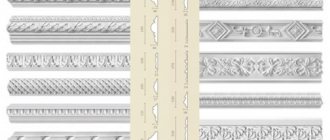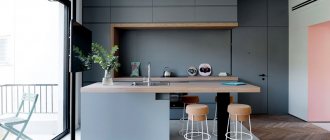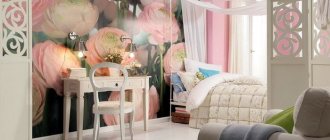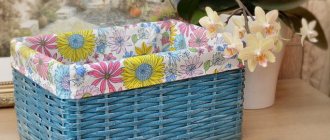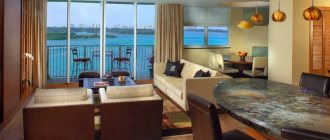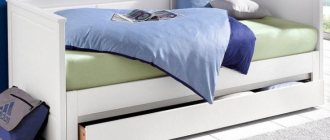Properties of curtain materials
The type of finished window textiles and the room as a whole will depend on the material chosen. Important parameters :
- fabric structure;
- ability to drape;
- resistance to washing, dry cleaning, sunlight;
- ability to absorb odors;
- flammability (for public institutions).
The variety of available fabrics for curtains is expanding with the development of the latest technologies; laser-perforated fabrics have appeared with a unique pattern in light, any photo.
After processing textiles with a special chemical composition, they receive additional properties :
- waterproof;
- protection against burnout;
- non-flammability;
- rigidity;
- crease resistance;
- wear resistance.
Features of crocheted kitchen curtains
Knitted curtains (loin knitting, macrame techniques, etc.) are distinguished by a variety of patterns and colors, but their creation takes a lot of time, and the finished products require careful care. They must be washed by hand at a temperature not exceeding 30°C using liquid detergent, and should not be wrung out or stretched when wet.
Knitted curtains are varied.
Popular fabrics for curtains
Velvet is a heavy fabric with short pile on the front side.
Well suited for curtains with drapery, ideally protects the room from sunlight and noise.
Dry cleaning is recommended, washing is not allowed (the pile becomes wrinkled and the appearance deteriorates).
Chenille is a fabric with a pile on the surface, it can be jacquard (with a pattern of smooth and fluffy threads). Chenille curtains are more suitable for an office, living room, or children's room.
They are dense, form a beautiful drape, hardly wrinkle, protect from sunlight and muffle noise. Dry cleaning recommended .
Jacquard is a material with a two-layer pattern due to the interweaving of threads, this gives it strength and durability.
It looks impressive and is resistant to the damaging effects of sunlight.
Taffeta - curtains made from it are spectacular in the office, the fabric protects from sunlight and looks presentable.
Tapestry is a pleasant-to-touch 100% cotton textile.
It can be painted well in a variety of colors, is suitable for curtains, and is popular with customers.
Curtains
Curtains are curtains made of dense material that are used together with thin and light curtains. Such products practically do not allow sunlight to pass through.
Atlas
Difficult to care for and expensive fabric that looks great and drapes well. For curtains, it is better to choose artificial satin. This material is easy to use, cheaper than natural material and lasts a long time.
Satin is an expensive fabric.
Jacquard
Fabric with complex weaving. Jacquard is made from synthetic, cotton, blended fabric using a special weaving technique. The material is suitable for curtains and decorative transverse stripes that decorate window openings.
Velvet and velor
The fabrics look elegant, but are not suitable for the kitchen. However, velvet and velor curtains look great in the living room or bedroom.
Velvet is a fabric with cut pile.
Brocade
Material with an original texture is best used in classic interiors. Such curtains are unlikely to be appropriate in the dining room or kitchen: the fabric will fade and become dirty. It is better to use the material when decorating the interior of living rooms.
Taffeta
Taffeta is an expensive fabric that has good performance characteristics: density, hypoallergenicity, wear resistance, and environmental friendliness. Curtains made from this material are heavy, but drape well.
Taffeta is a type of glossy, dense, thin fabric.
Sackcloth
Coarse fabric is obtained from jute, flax, and hemp. Burlap is suitable for Roman roller blinds, interior design in rustic and Provence styles.
Criteria for choosing fabrics for curtains
To choose the right fabric, it is important to know what requirements it must meet. Main factors when choosing textiles for curtains :
- purpose of the room;
- interior color scheme;
- ceiling height;
- window size and location.
Depending on the function that the curtains should perform in the room, they can:
- protect from bright sunlight;
- keep warm;
- disguise flaws in the finishing;
- create the effect of a large or small room.
Curtains made of 100% polyester or with a small addition of cotton are more practical.
This fabric does not lose its shape after washing if all recommendations are followed (water temperature not exceeding 40 degrees).
Velvet curtains require only professional cleaning . It is not advisable to hang curtains made of cotton and silk fabrics in a sunny room, as they fade and lose their appearance. Such curtains would not look appropriate in the kitchen.
Satin and jacquard materials are considered traditional and more formal; they can decorate any room and form beautiful folds when draped.
Soft transparent fabrics are used as independent curtains or in combination with heavy draperies. Curtains made of fabric with a printed pattern are suitable for interiors in modern and classic styles.
In a children's room, curtain fabric must meet the basic requirement: practicality. It is better if it is dense, protects well from light, and is easy to wash. It is advisable to use textiles made from natural materials , such as linen, with funny children's drawings.
Synthetic kitchen curtains
Synthetic fabrics have many advantages. Synthetics are less prone to wrinkles, can be dyed, do not absorb odors, and repel dirt better than natural materials.
Polyacrylic (acrylic)
The material looks and feels like wool. Thick, non-fading curtains (blackout) are sewn from polyacrylic; the material is used for upholstery. It is better not to use such curtains in the kitchen, because they absorb fats and oils that are difficult to remove.
Polyacrylic curtains do not fade in the sun.
Polyester
Polyester is made from polyester fibers that are obtained from petroleum refining. Features of the technology may differ depending on the material with what properties you want to obtain as a result.
For example, viscose fibers can be added to polyester to make the fabric thin and smooth, or wool to obtain a matte surface.
Rules for caring for curtains made from a mixture of fibers and polyester:
- use machine wash at a temperature of no more than 40°C;
- do not bleach (if it is heavily soiled, it is better to take it to the dry cleaner);
- Do not iron the fabric, just shake after washing and dry.
Polyester curtains are made from polyester fibers.
Polyamide
Polyamide fibers are made from organic matter. The material is not used in its 100% form. Polyamide is mixed with other fibers to improve the performance of the finished product. The most common type is nylon material.
Caring for home textiles made of nylon:
- wash at a temperature not exceeding 40°C;
- do not use air conditioning;
- do not squeeze, because the fabric has water-repellent properties;
- do not iron the products (you can use the gentle mode without steaming).
Polyamide fibers have water-repellent properties.
Polyurethane
Polyurethane is made artificially. The finished material is durable and has good performance characteristics, but can only be washed on delicate cycles.
Fabrics for curtains depending on the interior
Quite often, apartments use a classic version of textile window decoration: two panels made of different materials. Usually a light transparent fabric completely covers the window, with thick curtains on the sides.
Thick fabrics give a feeling of warmth and comfort, while transparent fabrics give a feeling of lightness. To decorate windows, a lambrequin is often used to cover the cornice and part of the curtains. This technique gives the image some completeness.
It is advisable not to use lambrequins in rooms with low ceilings, it looks cumbersome.
An interior in a classic style requires heavy types of materials for curtains: French scallops look impressive, beautifully falling in lush folds.
Roman blinds are more consistent with high-tech style. For the Empire style, it is customary to use expensive fabrics: silk, velvet.
Gold embroidery is possible, especially in combination with purple.
Baroque style - perhaps the most luxurious draperies , multi-layered of expensive and heavy fabrics, and the composition is completed by a complex lambrequin made of intertwining elements.
The decor includes glass beads, fringe, ruffles, curtains are picked up and draped with cords, falling in lush folds to the floor.
When choosing the best fabrics for curtains, it is important that the room reflects the individuality of the occupants.
You can be creative and paint the textiles, decorate them with appliqués or beads. Fabrics have been created with luminescent threads that glow in the dark or with grains that create a luminous pattern on the curtains.
In the dark, such a room looks mysterious and romantic, and the interior is stylish.
